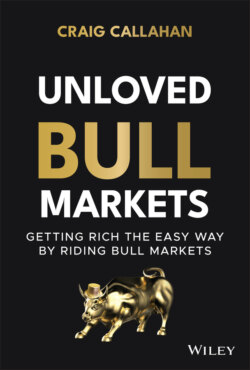Читать книгу Unloved Bull Markets - Craig Callahan - Страница 20
Does Rate of Return Matter?
ОглавлениеYou bet it does. From the low on March 9, 2009, to the peak on February 19, 2020, the S&P 500 Index gained at an annual rate of 18.3%. We will not use that for this example because it was above average and exceptional. Let's tone it down and use 10% per year, right near the historic average for equities. Figure 1.7 shows the growth of $1.00 over twenty years at 10% per year. It also shows the growth at 5% per year, a rate slightly above what the public fund pension plans earned during the bull market.
Of course, for the public funds the starting amount could easily be $1 billion, so after twenty years there is a $4 billion gap for each billion invested. Even after ten years the gap is almost $1 billion per billion invested. For an individual investor, if the starting amount is $100,000 the difference is over a $400,000 after twenty years. The same math applies to financial advisors for whom the primary determinant of the value of their practice is assets under management. The higher returns earned by the investors, the more the value of the practice grows. Rate of return and participating in bull markets matter because if the goal for retirement is to buy a residence in a tropical location or to travel, the seller of the residence or the travel agent doesn't take risk-adjusted returns. They take money. If the investor can tolerate a little volatility, the market can do the heavy lifting to get to retirement goals.
Figure 1.7 Compounding at 10% and 5%
A couple of years before the end of the eleven-year bull market, I was working out at my fitness center in Naples, Florida. A stock market channel was on most of the TVs and the market was up that day. One retired fellow joked to his buddies, “If the stock market keeps going up, I'll actually be able to afford my life style.”
